Business Law Management HND: Analysis of the Legal System
VerifiedAdded on 2024/04/26
|22
|3820
|201
Report
AI Summary
This report provides a comprehensive analysis of the English Legal System, including its structure, sources of law, and the roles of various legal professionals. It delves into the legislative process, highlighting the involvement of government departments and the passage of bills through the House of Commons and House of Lords. The report also examines employers' legal obligations related to occupational health and safety, workers' compensation, harassment, and equal opportunities, providing examples and case studies to illustrate these concepts. Furthermore, it offers legal solutions to hypothetical cases, applying relevant legislation such as the Employment Right Act and discussing alternative dispute resolution methods. The report concludes by emphasizing the importance of understanding the legal framework in business operations and ensuring compliance with relevant regulations.
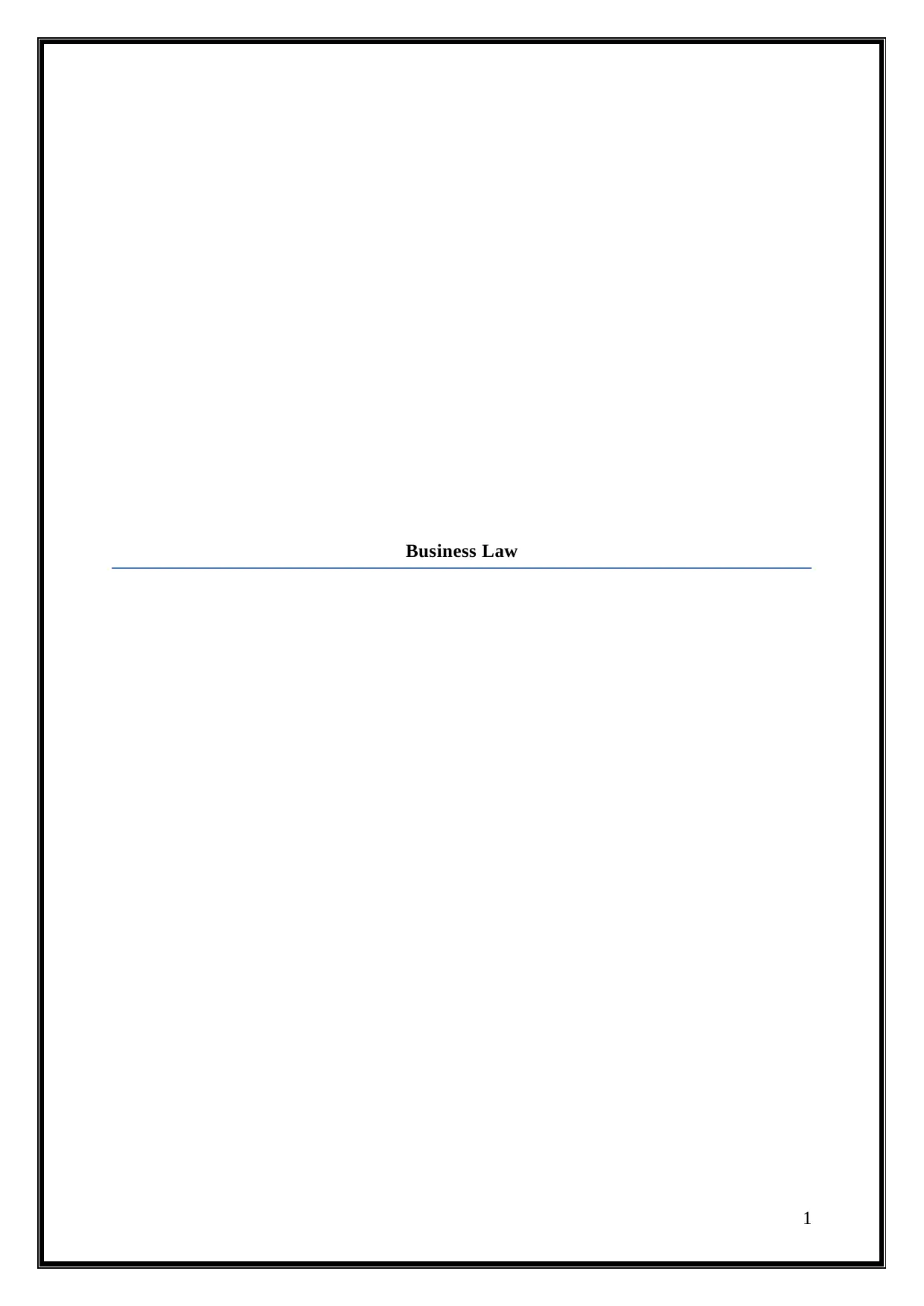
Business Law
1
1
Paraphrase This Document
Need a fresh take? Get an instant paraphrase of this document with our AI Paraphraser
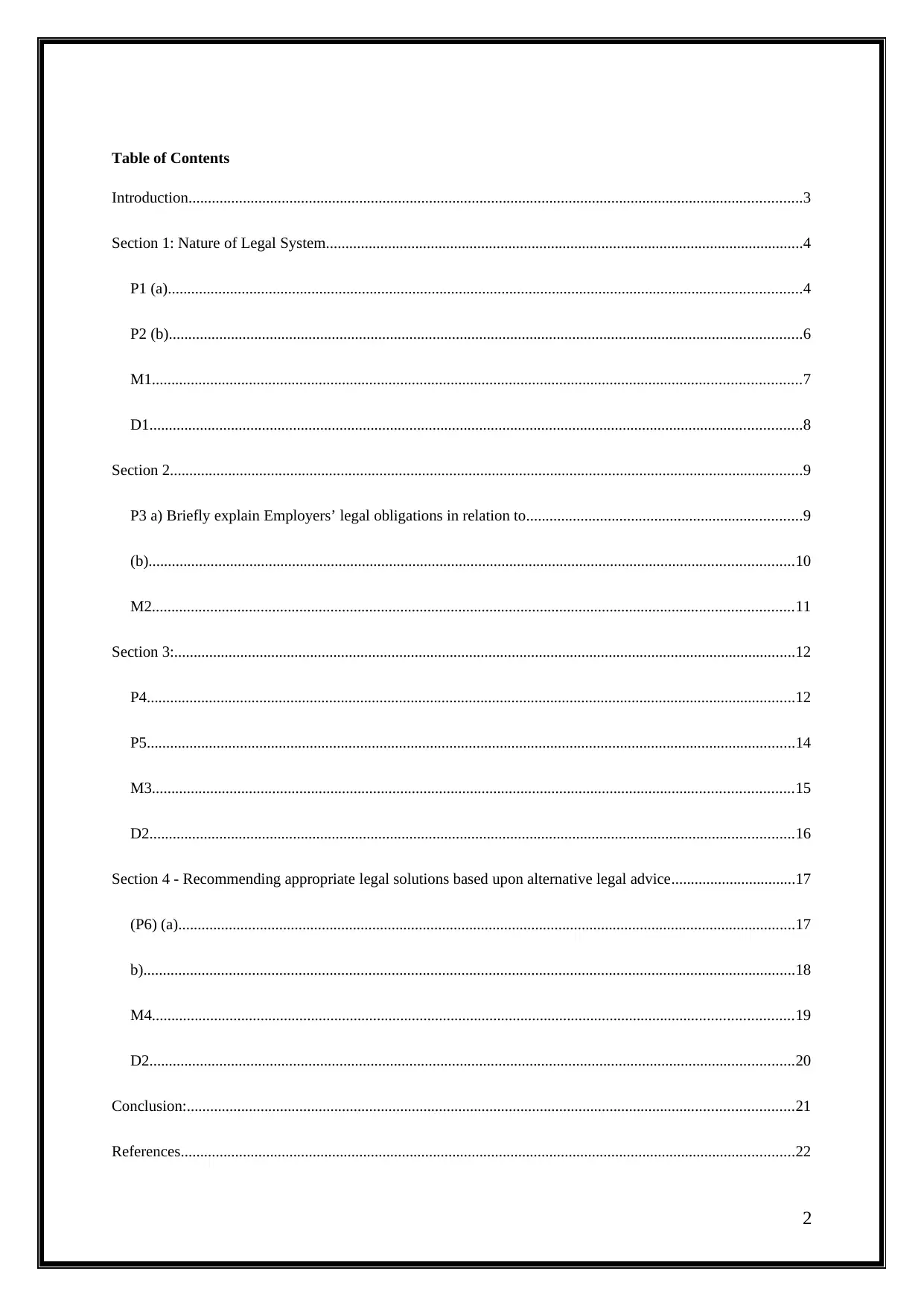
Table of Contents
Introduction..............................................................................................................................................................3
Section 1: Nature of Legal System...........................................................................................................................4
P1 (a)...................................................................................................................................................................4
P2 (b)...................................................................................................................................................................6
M1.......................................................................................................................................................................7
D1........................................................................................................................................................................8
Section 2...................................................................................................................................................................9
P3 a) Briefly explain Employers’ legal obligations in relation to.......................................................................9
(b)......................................................................................................................................................................10
M2.....................................................................................................................................................................11
Section 3:................................................................................................................................................................12
P4.......................................................................................................................................................................12
P5.......................................................................................................................................................................14
M3.....................................................................................................................................................................15
D2......................................................................................................................................................................16
Section 4 - Recommending appropriate legal solutions based upon alternative legal advice................................17
(P6) (a)...............................................................................................................................................................17
b)........................................................................................................................................................................18
M4.....................................................................................................................................................................19
D2......................................................................................................................................................................20
Conclusion:............................................................................................................................................................21
References..............................................................................................................................................................22
2
Introduction..............................................................................................................................................................3
Section 1: Nature of Legal System...........................................................................................................................4
P1 (a)...................................................................................................................................................................4
P2 (b)...................................................................................................................................................................6
M1.......................................................................................................................................................................7
D1........................................................................................................................................................................8
Section 2...................................................................................................................................................................9
P3 a) Briefly explain Employers’ legal obligations in relation to.......................................................................9
(b)......................................................................................................................................................................10
M2.....................................................................................................................................................................11
Section 3:................................................................................................................................................................12
P4.......................................................................................................................................................................12
P5.......................................................................................................................................................................14
M3.....................................................................................................................................................................15
D2......................................................................................................................................................................16
Section 4 - Recommending appropriate legal solutions based upon alternative legal advice................................17
(P6) (a)...............................................................................................................................................................17
b)........................................................................................................................................................................18
M4.....................................................................................................................................................................19
D2......................................................................................................................................................................20
Conclusion:............................................................................................................................................................21
References..............................................................................................................................................................22
2
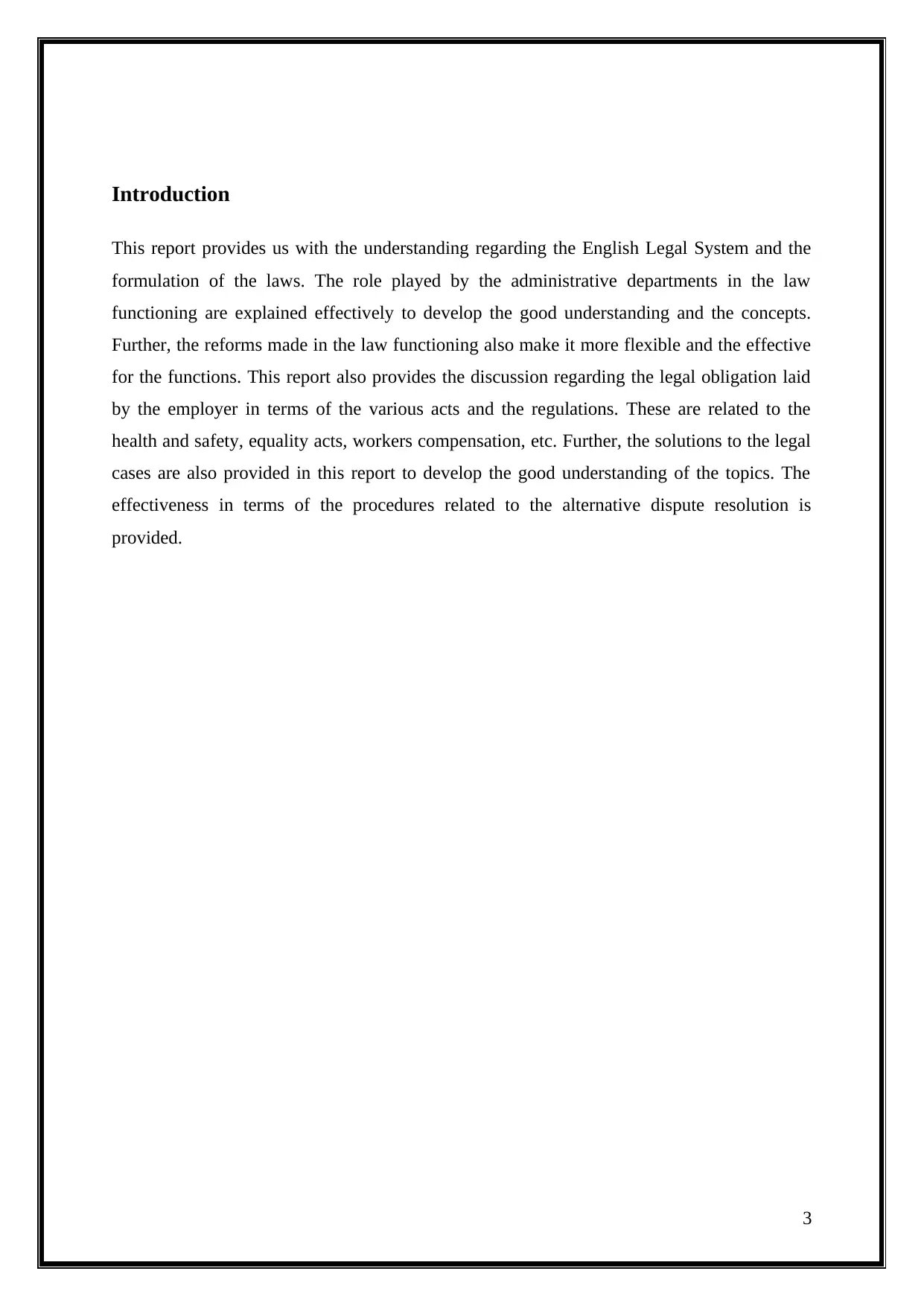
Introduction
This report provides us with the understanding regarding the English Legal System and the
formulation of the laws. The role played by the administrative departments in the law
functioning are explained effectively to develop the good understanding and the concepts.
Further, the reforms made in the law functioning also make it more flexible and the effective
for the functions. This report also provides the discussion regarding the legal obligation laid
by the employer in terms of the various acts and the regulations. These are related to the
health and safety, equality acts, workers compensation, etc. Further, the solutions to the legal
cases are also provided in this report to develop the good understanding of the topics. The
effectiveness in terms of the procedures related to the alternative dispute resolution is
provided.
3
This report provides us with the understanding regarding the English Legal System and the
formulation of the laws. The role played by the administrative departments in the law
functioning are explained effectively to develop the good understanding and the concepts.
Further, the reforms made in the law functioning also make it more flexible and the effective
for the functions. This report also provides the discussion regarding the legal obligation laid
by the employer in terms of the various acts and the regulations. These are related to the
health and safety, equality acts, workers compensation, etc. Further, the solutions to the legal
cases are also provided in this report to develop the good understanding of the topics. The
effectiveness in terms of the procedures related to the alternative dispute resolution is
provided.
3
⊘ This is a preview!⊘
Do you want full access?
Subscribe today to unlock all pages.

Trusted by 1+ million students worldwide

Section 1: Nature of Legal System
P1 (a)
English legal system is considered as a fountain which flows towards the United Kingdom. It
works with its main two divisions which are criminal and the civil divisions. The functioning
of both the divisions is different and distinct. The difference in them is due to the nature of
their functions which is related to both the criminal and the non-criminal nature. The
hierarchy used in the English Legal System is provided thereunder:
Supreme Court: The Supreme Court is considered as one of the higher courts in the
hierarchy. Its functioning is all the above courts and the disputes are settled in it by the parties
if they are not satisfied with the subordinate courts.
Court of Appeal: It is also called as a COA and is responsible for dealing with the cases
whose appeals are provided to other subordinate courts. Criminal division is responsible for
dealing with the cases which are of criminal nature while the civil division is responsible for
the cases which are of non-criminal nature (The judicial office international team, 2016).
High Court: The high court functions all those cases which are considered as an important
and of the high values. It is also considered as supervisory jurisdictions over all other
subordinate courts in the English legal system.
Crown Court: It is considered as a higher court which deals with the cases which are related
to the criminal natures.
Magistrate Court: It is considered as lower courts which is basically responsible for holding
the trials for the summary offenses and the preliminary hearing for the cases which are in
serious nature.
Sources of Law:
Precedents Precedents are considered to be a source which are provided by the
superior courts and which can be further used as a guideline by the
subordinate courts to provide the decisions
Acts of parliament In this form, all the functioning and the approvals are made by the
parliament. The draft used in the formulation of the law involves
the readings and then certification is provided by the Parliament
4
P1 (a)
English legal system is considered as a fountain which flows towards the United Kingdom. It
works with its main two divisions which are criminal and the civil divisions. The functioning
of both the divisions is different and distinct. The difference in them is due to the nature of
their functions which is related to both the criminal and the non-criminal nature. The
hierarchy used in the English Legal System is provided thereunder:
Supreme Court: The Supreme Court is considered as one of the higher courts in the
hierarchy. Its functioning is all the above courts and the disputes are settled in it by the parties
if they are not satisfied with the subordinate courts.
Court of Appeal: It is also called as a COA and is responsible for dealing with the cases
whose appeals are provided to other subordinate courts. Criminal division is responsible for
dealing with the cases which are of criminal nature while the civil division is responsible for
the cases which are of non-criminal nature (The judicial office international team, 2016).
High Court: The high court functions all those cases which are considered as an important
and of the high values. It is also considered as supervisory jurisdictions over all other
subordinate courts in the English legal system.
Crown Court: It is considered as a higher court which deals with the cases which are related
to the criminal natures.
Magistrate Court: It is considered as lower courts which is basically responsible for holding
the trials for the summary offenses and the preliminary hearing for the cases which are in
serious nature.
Sources of Law:
Precedents Precedents are considered to be a source which are provided by the
superior courts and which can be further used as a guideline by the
subordinate courts to provide the decisions
Acts of parliament In this form, all the functioning and the approvals are made by the
parliament. The draft used in the formulation of the law involves
the readings and then certification is provided by the Parliament
4
Paraphrase This Document
Need a fresh take? Get an instant paraphrase of this document with our AI Paraphraser

(Slapper and Kelly, 2013).
Customs Customs are used as a source which helps the individuals to gain
the justice.
European laws It is based on the principles which are laid by the European Union
The role played by the solicitors, barristers and the judges:
Solicitors are considered as a professional who is considered to be legally responsible for
helping or guiding the clients on the disputes. The solicitors are also considered to be
responsible individual for the appointment of the barristers. Barristers are the one which is
responsible for performing the paper work. In the same way, the judges in the legal system
are considered to be responsible for providing the justice to the individuals.
5
Customs Customs are used as a source which helps the individuals to gain
the justice.
European laws It is based on the principles which are laid by the European Union
The role played by the solicitors, barristers and the judges:
Solicitors are considered as a professional who is considered to be legally responsible for
helping or guiding the clients on the disputes. The solicitors are also considered to be
responsible individual for the appointment of the barristers. Barristers are the one which is
responsible for performing the paper work. In the same way, the judges in the legal system
are considered to be responsible for providing the justice to the individuals.
5
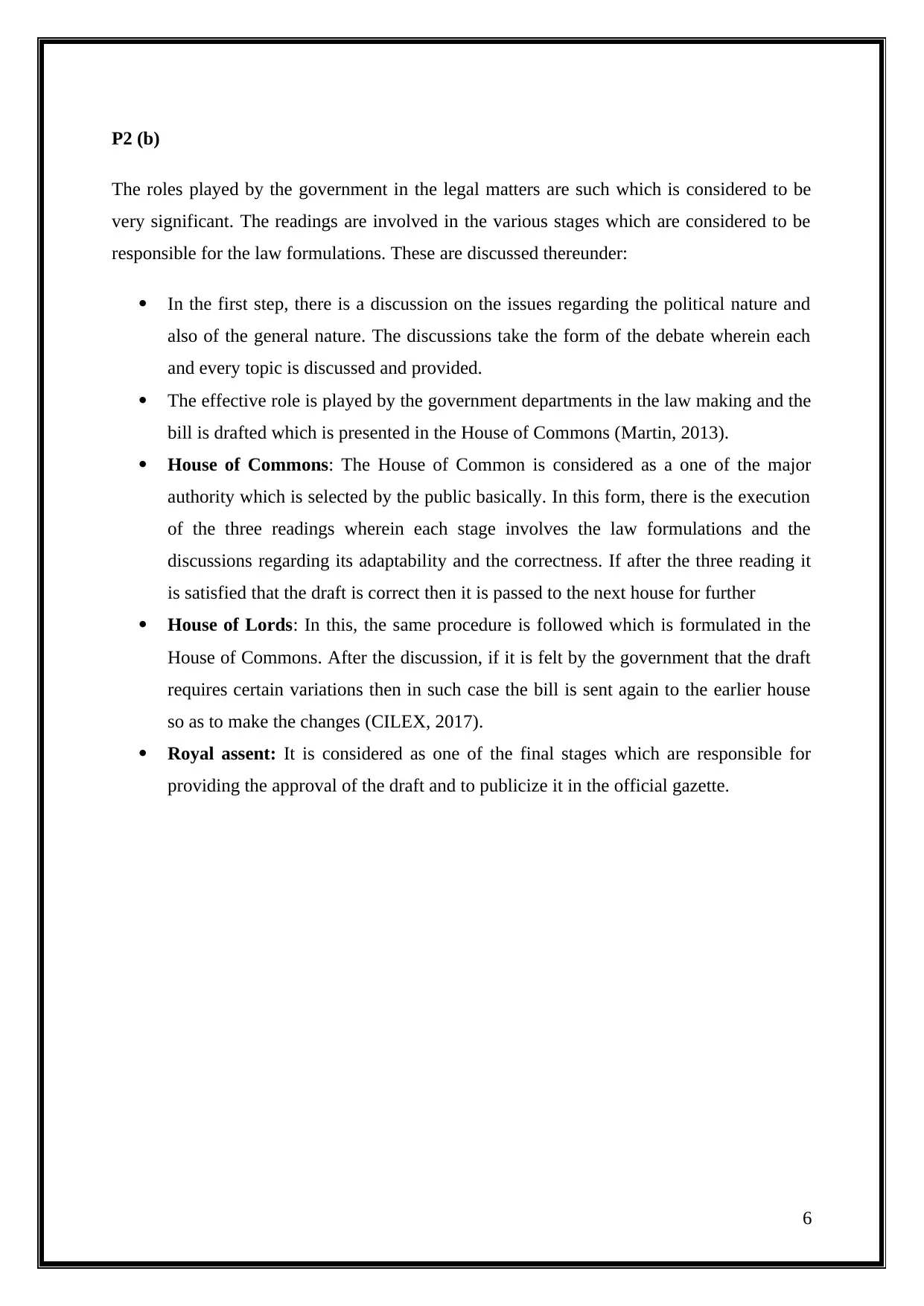
P2 (b)
The roles played by the government in the legal matters are such which is considered to be
very significant. The readings are involved in the various stages which are considered to be
responsible for the law formulations. These are discussed thereunder:
In the first step, there is a discussion on the issues regarding the political nature and
also of the general nature. The discussions take the form of the debate wherein each
and every topic is discussed and provided.
The effective role is played by the government departments in the law making and the
bill is drafted which is presented in the House of Commons (Martin, 2013).
House of Commons: The House of Common is considered as a one of the major
authority which is selected by the public basically. In this form, there is the execution
of the three readings wherein each stage involves the law formulations and the
discussions regarding its adaptability and the correctness. If after the three reading it
is satisfied that the draft is correct then it is passed to the next house for further
House of Lords: In this, the same procedure is followed which is formulated in the
House of Commons. After the discussion, if it is felt by the government that the draft
requires certain variations then in such case the bill is sent again to the earlier house
so as to make the changes (CILEX, 2017).
Royal assent: It is considered as one of the final stages which are responsible for
providing the approval of the draft and to publicize it in the official gazette.
6
The roles played by the government in the legal matters are such which is considered to be
very significant. The readings are involved in the various stages which are considered to be
responsible for the law formulations. These are discussed thereunder:
In the first step, there is a discussion on the issues regarding the political nature and
also of the general nature. The discussions take the form of the debate wherein each
and every topic is discussed and provided.
The effective role is played by the government departments in the law making and the
bill is drafted which is presented in the House of Commons (Martin, 2013).
House of Commons: The House of Common is considered as a one of the major
authority which is selected by the public basically. In this form, there is the execution
of the three readings wherein each stage involves the law formulations and the
discussions regarding its adaptability and the correctness. If after the three reading it
is satisfied that the draft is correct then it is passed to the next house for further
House of Lords: In this, the same procedure is followed which is formulated in the
House of Commons. After the discussion, if it is felt by the government that the draft
requires certain variations then in such case the bill is sent again to the earlier house
so as to make the changes (CILEX, 2017).
Royal assent: It is considered as one of the final stages which are responsible for
providing the approval of the draft and to publicize it in the official gazette.
6
⊘ This is a preview!⊘
Do you want full access?
Subscribe today to unlock all pages.

Trusted by 1+ million students worldwide
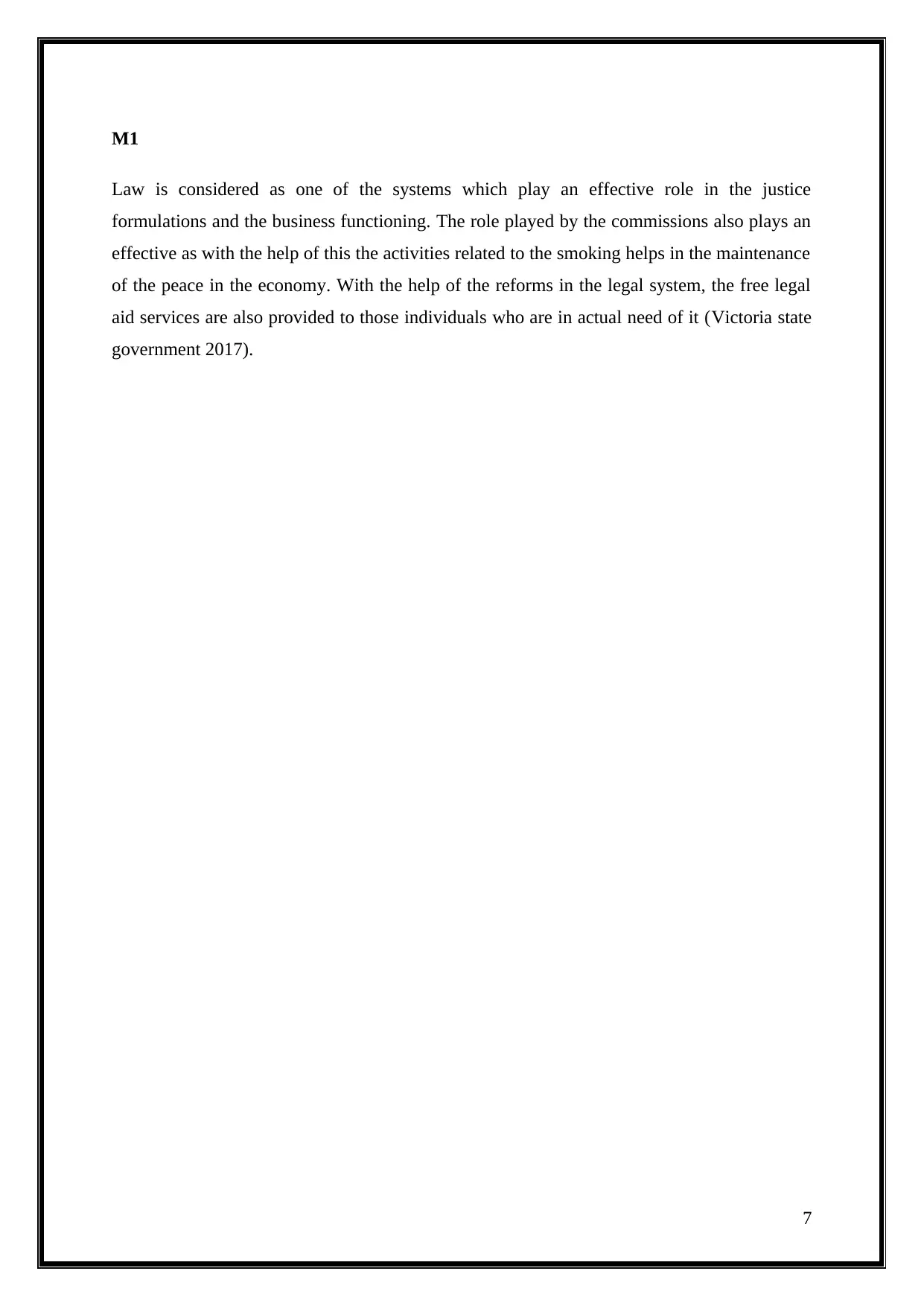
M1
Law is considered as one of the systems which play an effective role in the justice
formulations and the business functioning. The role played by the commissions also plays an
effective as with the help of this the activities related to the smoking helps in the maintenance
of the peace in the economy. With the help of the reforms in the legal system, the free legal
aid services are also provided to those individuals who are in actual need of it (Victoria state
government 2017).
7
Law is considered as one of the systems which play an effective role in the justice
formulations and the business functioning. The role played by the commissions also plays an
effective as with the help of this the activities related to the smoking helps in the maintenance
of the peace in the economy. With the help of the reforms in the legal system, the free legal
aid services are also provided to those individuals who are in actual need of it (Victoria state
government 2017).
7
Paraphrase This Document
Need a fresh take? Get an instant paraphrase of this document with our AI Paraphraser

D1
In case of the English Legal System, the basic value which is apportioned is with the
principles which are laid in the common law. The legal system which operates in the United
Kingdom helps in providing both the flexibility and certain advantages. This also helps in the
smoother operations of the justice in the UK. Whereas when the legal system of the United
States is considered then it is termed as an institutionalized. There is also not involved any of
the tribunal system in the United States (Taylor and Emir, 2015).
8
In case of the English Legal System, the basic value which is apportioned is with the
principles which are laid in the common law. The legal system which operates in the United
Kingdom helps in providing both the flexibility and certain advantages. This also helps in the
smoother operations of the justice in the UK. Whereas when the legal system of the United
States is considered then it is termed as an institutionalized. There is also not involved any of
the tribunal system in the United States (Taylor and Emir, 2015).
8
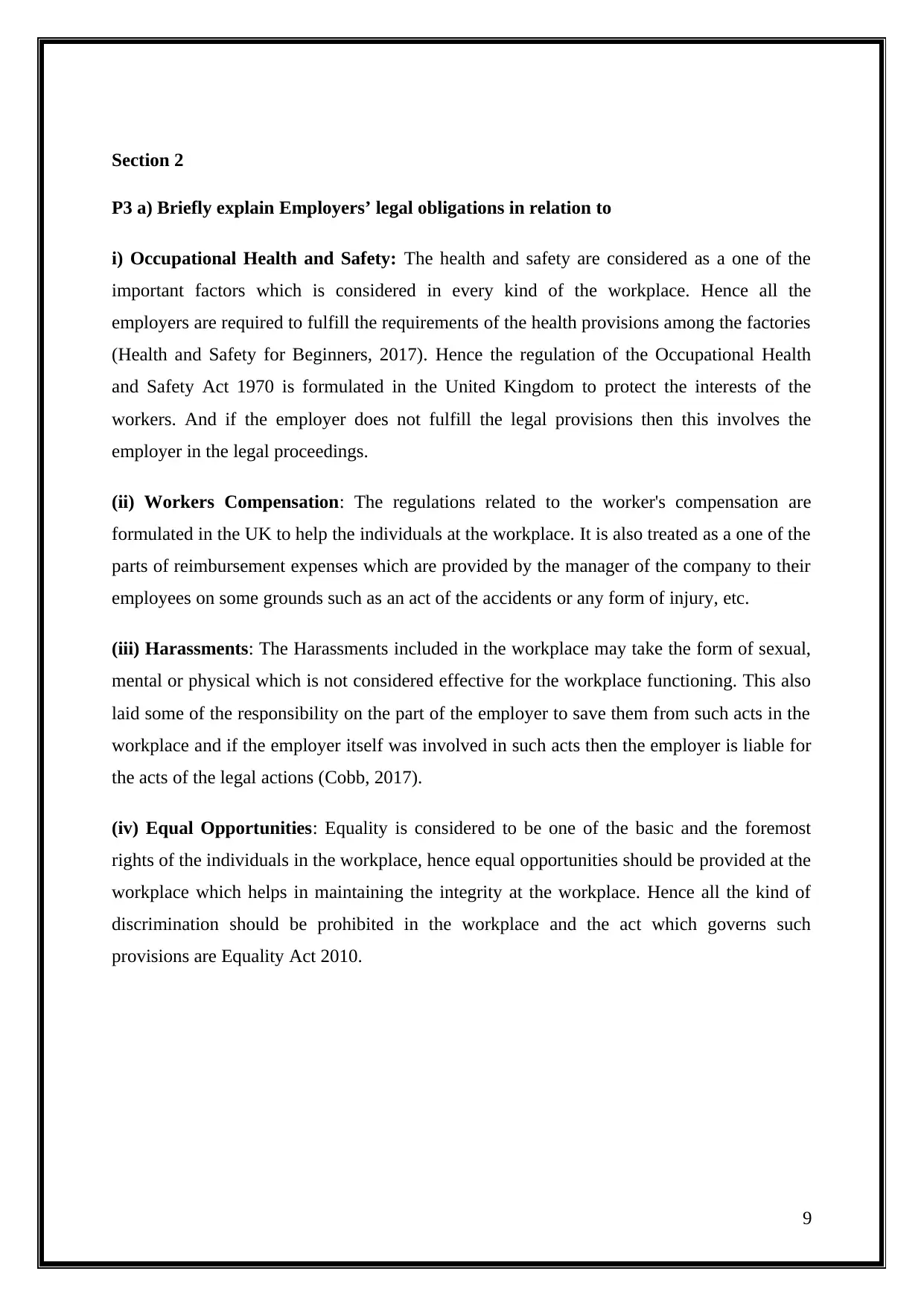
Section 2
P3 a) Briefly explain Employers’ legal obligations in relation to
i) Occupational Health and Safety: The health and safety are considered as a one of the
important factors which is considered in every kind of the workplace. Hence all the
employers are required to fulfill the requirements of the health provisions among the factories
(Health and Safety for Beginners, 2017). Hence the regulation of the Occupational Health
and Safety Act 1970 is formulated in the United Kingdom to protect the interests of the
workers. And if the employer does not fulfill the legal provisions then this involves the
employer in the legal proceedings.
(ii) Workers Compensation: The regulations related to the worker's compensation are
formulated in the UK to help the individuals at the workplace. It is also treated as a one of the
parts of reimbursement expenses which are provided by the manager of the company to their
employees on some grounds such as an act of the accidents or any form of injury, etc.
(iii) Harassments: The Harassments included in the workplace may take the form of sexual,
mental or physical which is not considered effective for the workplace functioning. This also
laid some of the responsibility on the part of the employer to save them from such acts in the
workplace and if the employer itself was involved in such acts then the employer is liable for
the acts of the legal actions (Cobb, 2017).
(iv) Equal Opportunities: Equality is considered to be one of the basic and the foremost
rights of the individuals in the workplace, hence equal opportunities should be provided at the
workplace which helps in maintaining the integrity at the workplace. Hence all the kind of
discrimination should be prohibited in the workplace and the act which governs such
provisions are Equality Act 2010.
9
P3 a) Briefly explain Employers’ legal obligations in relation to
i) Occupational Health and Safety: The health and safety are considered as a one of the
important factors which is considered in every kind of the workplace. Hence all the
employers are required to fulfill the requirements of the health provisions among the factories
(Health and Safety for Beginners, 2017). Hence the regulation of the Occupational Health
and Safety Act 1970 is formulated in the United Kingdom to protect the interests of the
workers. And if the employer does not fulfill the legal provisions then this involves the
employer in the legal proceedings.
(ii) Workers Compensation: The regulations related to the worker's compensation are
formulated in the UK to help the individuals at the workplace. It is also treated as a one of the
parts of reimbursement expenses which are provided by the manager of the company to their
employees on some grounds such as an act of the accidents or any form of injury, etc.
(iii) Harassments: The Harassments included in the workplace may take the form of sexual,
mental or physical which is not considered effective for the workplace functioning. This also
laid some of the responsibility on the part of the employer to save them from such acts in the
workplace and if the employer itself was involved in such acts then the employer is liable for
the acts of the legal actions (Cobb, 2017).
(iv) Equal Opportunities: Equality is considered to be one of the basic and the foremost
rights of the individuals in the workplace, hence equal opportunities should be provided at the
workplace which helps in maintaining the integrity at the workplace. Hence all the kind of
discrimination should be prohibited in the workplace and the act which governs such
provisions are Equality Act 2010.
9
⊘ This is a preview!⊘
Do you want full access?
Subscribe today to unlock all pages.

Trusted by 1+ million students worldwide

(b)
The risks and the accidents are such common things which are considered part of any of the
workplace or the factory. In the given case it is provided that the girl is suffered the injury
due to the involvement of the accident at the workplace. The injury is caused to the girl's
hand and also some temporary from which she is affected severally. This act is involved in
the workplace due to the reason which is provided thereunder:
No training was provided to the workers to deal with the accidents.
The risks assessment procedure is also not involved in the workplace while placing
the machine and fryers (Health and Safety for Beginners, 2017).
On the day of the accident there is also the short availability of staff due to which
there is not the availability of the any of the leaders to monitor the working.
Hence from the above case and the scenario, it is provided that the employer is liable to under
the provisions of both the Health and Safety Act and the Employment Protection Act which
hold him liable to make the payment of all the expenses and also provides all medical
benefits on the part of the employer.
10
The risks and the accidents are such common things which are considered part of any of the
workplace or the factory. In the given case it is provided that the girl is suffered the injury
due to the involvement of the accident at the workplace. The injury is caused to the girl's
hand and also some temporary from which she is affected severally. This act is involved in
the workplace due to the reason which is provided thereunder:
No training was provided to the workers to deal with the accidents.
The risks assessment procedure is also not involved in the workplace while placing
the machine and fryers (Health and Safety for Beginners, 2017).
On the day of the accident there is also the short availability of staff due to which
there is not the availability of the any of the leaders to monitor the working.
Hence from the above case and the scenario, it is provided that the employer is liable to under
the provisions of both the Health and Safety Act and the Employment Protection Act which
hold him liable to make the payment of all the expenses and also provides all medical
benefits on the part of the employer.
10
Paraphrase This Document
Need a fresh take? Get an instant paraphrase of this document with our AI Paraphraser
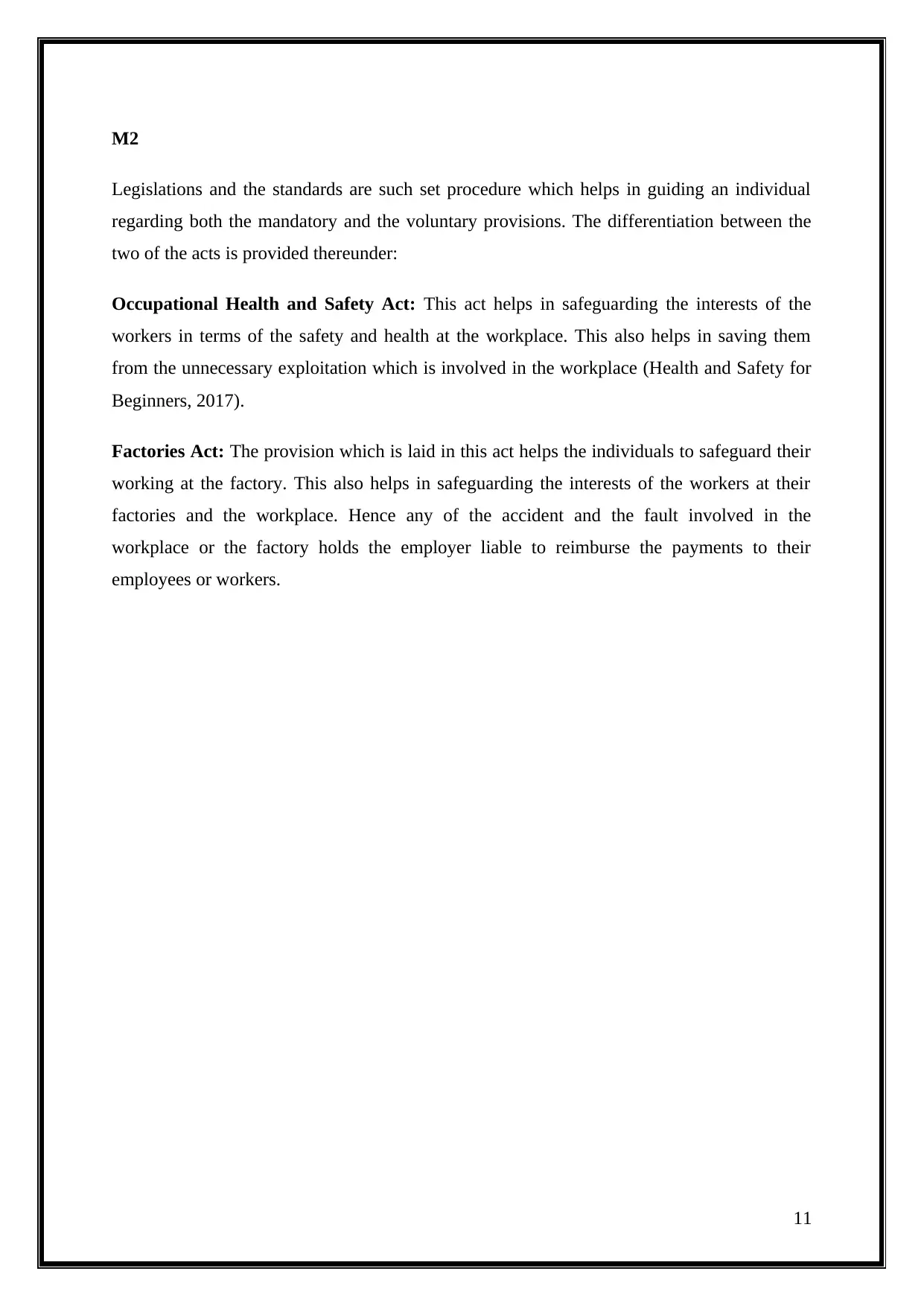
M2
Legislations and the standards are such set procedure which helps in guiding an individual
regarding both the mandatory and the voluntary provisions. The differentiation between the
two of the acts is provided thereunder:
Occupational Health and Safety Act: This act helps in safeguarding the interests of the
workers in terms of the safety and health at the workplace. This also helps in saving them
from the unnecessary exploitation which is involved in the workplace (Health and Safety for
Beginners, 2017).
Factories Act: The provision which is laid in this act helps the individuals to safeguard their
working at the factory. This also helps in safeguarding the interests of the workers at their
factories and the workplace. Hence any of the accident and the fault involved in the
workplace or the factory holds the employer liable to reimburse the payments to their
employees or workers.
11
Legislations and the standards are such set procedure which helps in guiding an individual
regarding both the mandatory and the voluntary provisions. The differentiation between the
two of the acts is provided thereunder:
Occupational Health and Safety Act: This act helps in safeguarding the interests of the
workers in terms of the safety and health at the workplace. This also helps in saving them
from the unnecessary exploitation which is involved in the workplace (Health and Safety for
Beginners, 2017).
Factories Act: The provision which is laid in this act helps the individuals to safeguard their
working at the factory. This also helps in safeguarding the interests of the workers at their
factories and the workplace. Hence any of the accident and the fault involved in the
workplace or the factory holds the employer liable to reimburse the payments to their
employees or workers.
11
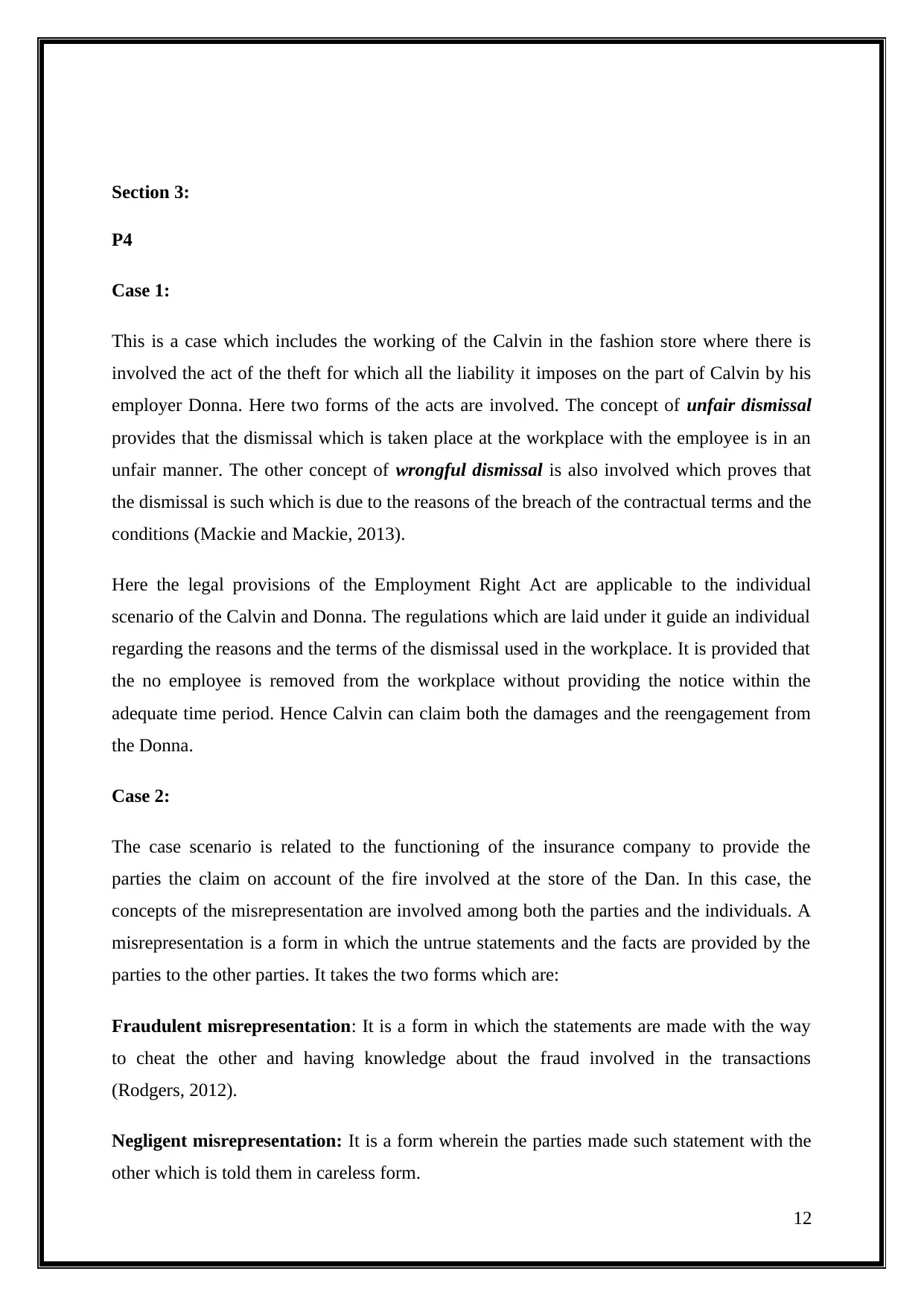
Section 3:
P4
Case 1:
This is a case which includes the working of the Calvin in the fashion store where there is
involved the act of the theft for which all the liability it imposes on the part of Calvin by his
employer Donna. Here two forms of the acts are involved. The concept of unfair dismissal
provides that the dismissal which is taken place at the workplace with the employee is in an
unfair manner. The other concept of wrongful dismissal is also involved which proves that
the dismissal is such which is due to the reasons of the breach of the contractual terms and the
conditions (Mackie and Mackie, 2013).
Here the legal provisions of the Employment Right Act are applicable to the individual
scenario of the Calvin and Donna. The regulations which are laid under it guide an individual
regarding the reasons and the terms of the dismissal used in the workplace. It is provided that
the no employee is removed from the workplace without providing the notice within the
adequate time period. Hence Calvin can claim both the damages and the reengagement from
the Donna.
Case 2:
The case scenario is related to the functioning of the insurance company to provide the
parties the claim on account of the fire involved at the store of the Dan. In this case, the
concepts of the misrepresentation are involved among both the parties and the individuals. A
misrepresentation is a form in which the untrue statements and the facts are provided by the
parties to the other parties. It takes the two forms which are:
Fraudulent misrepresentation: It is a form in which the statements are made with the way
to cheat the other and having knowledge about the fraud involved in the transactions
(Rodgers, 2012).
Negligent misrepresentation: It is a form wherein the parties made such statement with the
other which is told them in careless form.
12
P4
Case 1:
This is a case which includes the working of the Calvin in the fashion store where there is
involved the act of the theft for which all the liability it imposes on the part of Calvin by his
employer Donna. Here two forms of the acts are involved. The concept of unfair dismissal
provides that the dismissal which is taken place at the workplace with the employee is in an
unfair manner. The other concept of wrongful dismissal is also involved which proves that
the dismissal is such which is due to the reasons of the breach of the contractual terms and the
conditions (Mackie and Mackie, 2013).
Here the legal provisions of the Employment Right Act are applicable to the individual
scenario of the Calvin and Donna. The regulations which are laid under it guide an individual
regarding the reasons and the terms of the dismissal used in the workplace. It is provided that
the no employee is removed from the workplace without providing the notice within the
adequate time period. Hence Calvin can claim both the damages and the reengagement from
the Donna.
Case 2:
The case scenario is related to the functioning of the insurance company to provide the
parties the claim on account of the fire involved at the store of the Dan. In this case, the
concepts of the misrepresentation are involved among both the parties and the individuals. A
misrepresentation is a form in which the untrue statements and the facts are provided by the
parties to the other parties. It takes the two forms which are:
Fraudulent misrepresentation: It is a form in which the statements are made with the way
to cheat the other and having knowledge about the fraud involved in the transactions
(Rodgers, 2012).
Negligent misrepresentation: It is a form wherein the parties made such statement with the
other which is told them in careless form.
12
⊘ This is a preview!⊘
Do you want full access?
Subscribe today to unlock all pages.

Trusted by 1+ million students worldwide
1 out of 22
Related Documents
Your All-in-One AI-Powered Toolkit for Academic Success.
+13062052269
info@desklib.com
Available 24*7 on WhatsApp / Email
![[object Object]](/_next/static/media/star-bottom.7253800d.svg)
Unlock your academic potential
Copyright © 2020–2025 A2Z Services. All Rights Reserved. Developed and managed by ZUCOL.





